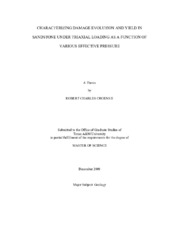| dc.description.abstract | Granular porous material is idealized as an elastic-plastic material, where macroscopic failure occurs at a critical stress by localized dilatant shear at low effective pressure and compactional cataclastic flow at high effective pressure. Yielding and accumulation of microscopic damage at sub-critical stress levels however also are important characteristic of the failure process. Here, load-reload triaxial compression tests are used to investigate damage development at low and high effective pressures, and validate prevailing models for failure across the brittle-ductile transition. Water saturated cylinders of Berea sandstone (18 percent porosity, 185 mu m grain size) were deformed at an axial strain rate of 4x10^-5 s^-1 to 8x10^-5 s^-1 pore pressures of 10, 20, and 30 MPa, and confining pressures of 50, 180, and 260 MPa to investigate the brittle, transitional, and ductile regimes. Measurement of sample strain and acoustic emissions are used to quantify the accumulation of damage and map equivalent damage states in stress space. Results illustrate that contours of equivalent damage for sub-critical stress states between yield and macroscopic failure are sub-parallel to the failure envelope across the brittle-ductile transition. Damage induced at one effective pressure (low, intermediate, or high pressure) has a systematic, but variable effect on failure at other effective pressure conditions, supporting the concept of distinct processes and damage development in the low and high pressure regimes. Reloaded samples in the low pressure regime with an initial loading in the high pressure regime are significantly weakened, but reloaded samples in the high pressure regime are unaffected by an initial loading in the high pressure regime. The behavior across the brittle-ductile transition is most consistent with a model based on two distinct yield envelopes, each associated with distinct damage mechanisms and a sharp transition between the low and high pressure regimes. | en |


